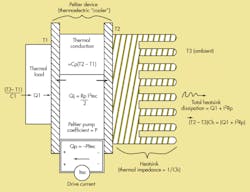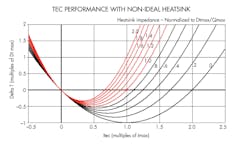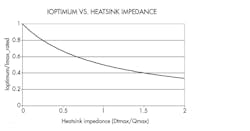This article is part of the TechXchange: Cool Designs.
Download this article in PDF format.
Thermoelectric coolers (TECs) are versatile temperature-control devices. They’re best thought of as solid-state heat pumps in which the direction and rate of heat flow can be manipulated by controlling the magnitude and polarity of the TEC drive current—the “Peltier Effect.”
Trouble is, simple and accurate (or even usefully approximate) design equations for TECs are hard to find. TEC selection, sizing of heatsinks, and design of control circuits are therefore matters for guesswork and/or experimentation. The model presented here has served well in a variety of designs. It requires, as input, only numbers that are routinely provided in TEC datasheets.
Though it’s a simplification of the gory details of TEC physics, the model is realistic and accurate enough to be used in most TEC design applications. For example, I personally successfully employed it in the design of diode laser temperature-control subsystems in planetary exploration instrumentation incorporated in the Mars Polar Lander MVACS and TEGA spectrometers and Deep Space 2 penetrator probes (1999 planetfall), as well as the Mars Curiosity rover SAM/TLS spectrometer (2012).
The model was especially useful in predicting TEC power requirements, and therefore of overall power budgeting and planning for the associated instrument packages. That capability is, of course, of vital importance in space applications.
The model predicts TEC thermal load temperature (T1) as a function of load heat production (Q1), TEC datasheet numbers (P, Cp, Rp), heatsink parameters (Ch), TEC drive current (Itec), and ambient temperature and ambient/load thermal conductivity (T3 and C1) (Fig. 1).
The model is summarized in a single second-order equation:
T1 = (-P*Itec + Itec2*Rp/2 + Q1)/(C1 + Cp) + (Q1 + Itec2*Rp)/Ch + T3
where:
P = Peltier constant = (Qmax + Imax2*Rp/2)/Imax
Qmax = maximum heat transfer from TEC datasheet (watts)
Rp = TEC resistance = Vmax/Imax = TEC datasheet drive ratings
Itec = TEC drive current (amperes)
Q1 = heat produced by thermal load (watts)
C1 = conductivity (watts/°C) of thermal load to ambient
Cp = TEC thermal conductivity = Qmax/δTmax from TEC datasheet
Ch = heatsink thermal conductivity to ambient
T3 = ambient temperature
Typical TEC design example numbers might come from a Melcor (Trenton, N.J.) type “F 0.45-32-05”:
P = 4.07 W/A
Rp = 4.8 ?
Cp = 0.026 W/°C
If we assume a routine application in which a zero-dissipation load such as a photovoltaic detector (Q1 = 0 W, C1 = 0.01 W/°C) needs to be thermostatted at 0°C, a good question might be: Suppose we select a moderate-sized heatsink with Ch = 0.2 W/°C; what is the warmest ambient temperature against which the 0° setpoint can be held?
Plugging these numbers into the model, the equation predicts that T3 = 35.2°C at Itec = 0.62 A will be the limit. But what if the system needs to operate in warmer (T3 c.a. 40°C) ambients? Melcor rates this TEC (Imax) for 0.8 A and a δT of up to 67°C. Can’t we hold the setpoint against hotter ambients just by driving the TEC a little harder than 0.62 A?
Surprisingly, the answer is a resounding “No!” If Itec increases from 0.62 A to 0.8 A, the heatsink will warm up by approximately 8°C and overwhelm the effect of additional Peltier heat transport. Consequently, T1 will move in the wrong direction and actually rise by 3°C.
In this example, T1 versus Itec reverses the slope around Itec = 0.62 A, and if Itec is allowed to exceed this limit, feedback phase reversal and control-loop runaway may occur. The only ways to improve the ambient temperature operating range are to either increase the heatsink’s capacity (Ch > 7.2 W/°C) or improve load thermal insulation (C1 < 0.01 W/°C).
Actually, an important prediction (and little-known fact) that comes out of this model is that reversal of the steady-state T1 versus Itec relation at:
Imax* = (P*Ch)/{Rp[Ch + 2(C1 +Cp)]}
will occur for all load/TEC/heatsink combinations. It’s critical to limit Itec to this maximum-cooling value. Otherwise, there’s a risk of thermostat latchup due to this reversal of the Itec/T1 relationship.
Other useful predictions available from the model include maximum cooling as a function of heatsink thermal impedance (Fig. 2).
Itec for maximum cooling, likewise versus heatsink impedance (Fig. 3).




